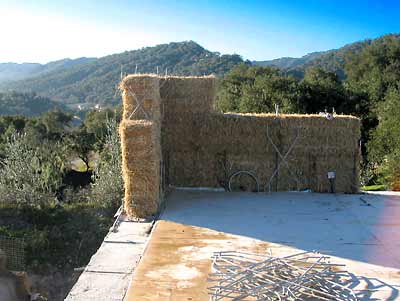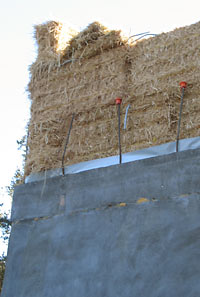UC Berkeley Press Release
 |
Straw bales held in place by steel bars form the core of the Spar and Membrane System being used to construct the Rancho Arroyo Grande winery near San Simeon, CA. (Photos by William Robertson) |
UC Berkeley architecture professor's new building system may offer solutions to quake-ravaged Iran
BERKELEY – University of California, Berkeley, architecture professor Gary Black says he has a safe, simple and affordable solution to rebuilding the quake-ravaged city of Bam, Iran, where 41,000 people died after a 6.7 magnitude temblor earlier this year.
His answer: a construction system of straw bales and prefabricated steel bars encased in thin membranes of concrete, or the Spar and Membrane System (SMS). The system, he said in an interview, is an ideal fit for low-rise buildings in seismically unsettled California, Iran and other regions that share similar geological conditions.
"Since the main materials - an agricultural by-product and concrete - are readily available worldwide, and since the construction is relatively low tech, it would be ideal for rebuilding in Iran," Black said.
For the past decade, he has been testing and perfecting the system, producing aesthetically appealing small and large buildings. The system has been used in a church meeting hall in Kansas, a small winery in the foothills of California's Sierra, and in a 7,000-square-foot villa in Sonoma, Calif., that survived, without any damage, a quake in 2000 that measured 5.2 on the Richter scale and was centered just eight miles away.
 A thin layer of concrete is applied to the straw bales to create the finished wall. |
The system - copyrighted by the Berkeley-based Integrated Structures, Inc. (ISI) firm that is headed by Black - also is the cornerstone of the 100,000-square-foot Rancho Arroyo Grande winery complex being constructed not far from San Simeon, Calif., where a 6.5 magnitude earthquake last month left buildings in shambles and two people dead. This spring, Black will start work in India on a 240-bed, dormitory-style building with the SMS system in a project being financed by the government and private business for national athletic games. Black also has designed a 45,000-square-foot building with SMS to be located about 900 yards from the Hayward Fault, engineered to be operational 24 hours after a 7.5 quake on that fault.
"We have a system that is constructable at a very low cost," he said. "It is completely viable and affordable."
Kudos for the system come from William Robertson, project manager and the owner's representative for the Rancho Arroyo Grande project.
"We had experimented with a variety of techniques involving straw bales," said Robertson. "However, prior to ISI's involvement, structural components and erection procedures involving straw bales were costly and difficult to implement. The Spar Membrane System simplifies construction, greatly enhances insulating properties, broadens our aesthetic options, and provides superior seismic performance while utilizing simple inexpensive building materials found internationally."
The SMS system has reduced the cost of the 100,000-square-foot facility by approximately 20 percent and will reduce the cost of operation by 15 percent annually, Robertson said. He calls Black "an amazing oracle of creative and technical solutions."
Black also has strong support from his UC Berkeley colleague, Abolhassan Astaneh, an Iranian-American professor of engineering. Black and Astaneh made headlines in 1997 with the design of a striking cable-stayed bridge, dubbed the "sail bridge," to replace the eastern span of the San Francisco-Oakland Bay Bridge that was damaged by the 1989 Loma Prieta earthquake.
"The SMS system would be a very good system in Iran. It is relatively light, yet strong, and ductile enough to withstand the ground shaking," said Astaneh. The main reason for the high death toll in the Bam quake was the collapse of the relatively heavy and brittle mud and brick houses, he added.
"If you want to survive earthquakes, you need to make your structure light, sufficiently strong and stiff, and tie it together in a ductile way so it bends but doesn't break or fall apart," Astaneh said. "Systems like this one do all that well."
Straw building construction has been a staple in Europe for the past 400 years. It is popping up in the United States largely in response to a desire for environmentally friendly building techniques, and in response to a growing need to conserve energy.
Black said his system is green, energy efficient and good for withstanding fire as well as earthquakes. Design calculations indicate the geothermal walls constructed with SMS can withstand fire for at least two hours. A preliminary analysis shows that resistance may last five hours or more.
The system uses products such as wheat or rice straw, an agricultural by-product available in virtually unlimited supply. Rice straw, which is typically burned or buried in landfills, works with the concrete's thermodynamics to make buildings easier to heat in cool weather and easier to cool in hot weather. Black said all straw can be used for SMS, which has an insulation rating of about R-50, or three times the level required for buildings in California.
"Iran is very much like California," said Astaneh. "About one-quarter of the country has mountain ranges with snow in winter and mild temperatures in the summer. Another one-fourth is like Florida, hot during the day and quite cold during the night. The system will act as very good insulation against hot and cold weather."
A real breakthrough in simplifying the system, Black said, came with refinement of a technique to stabilize the bales with the spar assembly, thus eliminating the costly and more time-consuming use of wood bracing to erect the walls.
And his use of steel wire reinforcement to create the lightweight concrete walls that are one-forth to one-fifth the weight of standard mud or adobe of the same thickness makes the SMS building particularly resistant to the damage caused by the shaking of powerful earthquakes. The lighter weight, Black said, "is so significant, it's incredible."
Because of a one-to-one relationship between weight and force levels, he added, halving a wall's weight essentially doubles its ability to resist earthquake forces.
In answer to a plea for solutions to build safe, affordable housing for the thousands left homeless in Bam, Black hopes ultimately to gain the required clearances to build several prototype buildings there and exhibit his construction system's merits.
"From the construction point of view, it needs very little technological know-how and can be constructed by anyone with a small amount of training and practice," said Astaneh. "That is exactly what is needed for Iran. Black's system is exactly what they have been doing for more than 3,000 years (in Iran), but this has the most modern seismic resistance concepts in it. What Iranians have now is a 'mud coffin' that buries them as soon as a moderate earthquake hits."
The only high tech aspect of the SMS, Black said, is the application of concrete with a strong pressure gun, which is in common usage in the United States. But it would be possible for the concrete to be hand-applied, much like swimming pools once were built in the United States, as long as the walls aren't over two stories tall.
It takes about two weeks to build and complete the walls for a 3,600-square-foot, two-story SMS home, said Black, and the walls don't require insulation, sheet rock, siding, stucco or trim - thus considerably reducing the time and cost. In the United States, the typical construction cost is about $80 per square foot, but Black said costs would be even lower in Iran, which lacks the extensive uniform building code requirements of the United States.
Black hopes he gets a chance to demonstrate the value of his system in Iran.
"There is much suffering in the earthquake-torn region of Bam. The city will ultimately have to be rebuilt, hopefully in a way that won't result in a repeat showing," said Black.

